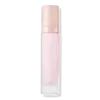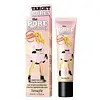What's inside
What's inside
 Key Ingredients
Key Ingredients

 Benefits
Benefits

 Concerns
Concerns

 Ingredients Side-by-side
Ingredients Side-by-side

Water
Skin ConditioningDimethicone
EmollientErythritol
HumectantPentylene Glycol
Skin ConditioningGlycerin
HumectantCetyl PEG/PPG-10/1 Dimethicone
EmulsifyingPolymethylsilsesquioxane
Pentaerythrityl Tetraisostearate
EmollientIsododecane
EmollientTrimethylsiloxysilicate
EmollientNylon-12
Polymethyl Methacrylate
Sodium Chloride
MaskingPhenoxyethanol
PreservativeHydroxyacetophenone
AntioxidantMagnesium Sulfate
Polysilicone-11
Disteardimonium Hectorite
StabilisingSodium Hyaluronate
HumectantTocopheryl Acetate
AntioxidantPropylene Carbonate
SolventParfum
MaskingBiosaccharide Gum-4
Skin ConditioningLaureth-12
EmulsifyingVitis Vinifera Seed Oil
EmollientTriethoxycaprylylsilane
CI 77007
Cosmetic ColorantCI 15850
Cosmetic ColorantWater, Dimethicone, Erythritol, Pentylene Glycol, Glycerin, Cetyl PEG/PPG-10/1 Dimethicone, Polymethylsilsesquioxane, Pentaerythrityl Tetraisostearate, Isododecane, Trimethylsiloxysilicate, Nylon-12, Polymethyl Methacrylate, Sodium Chloride, Phenoxyethanol, Hydroxyacetophenone, Magnesium Sulfate, Polysilicone-11, Disteardimonium Hectorite, Sodium Hyaluronate, Tocopheryl Acetate, Propylene Carbonate, Parfum, Biosaccharide Gum-4, Laureth-12, Vitis Vinifera Seed Oil, Triethoxycaprylylsilane, CI 77007, CI 15850
Dimethicone
EmollientCyclopentasiloxane
EmollientDimethicone/Vinyl Dimethicone Crosspolymer
Skin ConditioningIsononyl Isononanoate
EmollientDimethicone Crosspolymer
Emulsion StabilisingIsododecane
EmollientSilica
AbrasivePolymethyl Methacrylate
Mica
Cosmetic ColorantPhenoxyethanol
PreservativeTocopheryl Acetate
AntioxidantParfum
MaskingTin Oxide
AbrasiveLimonene
PerfumingTriethoxycaprylylsilane
BHT
AntioxidantTocopherol
AntioxidantCI 19140
Cosmetic ColorantCI 42090
Cosmetic ColorantCI 77007
Cosmetic ColorantCI 77163
Cosmetic ColorantCI 77491
Cosmetic ColorantCI 77492
Cosmetic ColorantCI 77499
Cosmetic ColorantCI 77891
Cosmetic ColorantDimethicone, Cyclopentasiloxane, Dimethicone/Vinyl Dimethicone Crosspolymer, Isononyl Isononanoate, Dimethicone Crosspolymer, Isododecane, Silica, Polymethyl Methacrylate, Mica, Phenoxyethanol, Tocopheryl Acetate, Parfum, Tin Oxide, Limonene, Triethoxycaprylylsilane, BHT, Tocopherol, CI 19140, CI 42090, CI 77007, CI 77163, CI 77491, CI 77492, CI 77499, CI 77891
Ingredients Explained
These ingredients are found in both products.
Ingredients higher up in an ingredient list are typically present in a larger amount.
This pigment is called Ultramarine blue lazurite. It gives a saturated blue color, but can be used to create other colors as well.
According to the manufacturer, it is usually made from kaolin, sodium sulfate, sodium carbonate, sulfur, and charcoal.
Dimethicone is a type of synthetic silicone created from natural materials such as quartz.
What it does:
Dimethicone comes in different viscosities:
Depending on the viscosity, dimethicone has different properties.
Ingredients lists don't always show which type is used, so we recommend reaching out to the brand if you have questions about the viscosity.
This ingredient is unlikely to cause irritation because it does not get absorbed into skin. However, people with silicone allergies should be careful about using this ingredient.
Note: Dimethicone may contribute to pilling. This is because it is not oil or water soluble, so pilling may occur when layered with products. When mixed with heavy oils in a formula, the outcome is also quite greasy.
Learn more about DimethiconeIsododecane is a fragrance, emollient, and solvent.
As an emollient, it helps your skin stay soft and hydrated. Emollients help trap moisture into your skin.
Isododecane's role as a solvent makes it a great texture enhancer. It spreads smoothly on skin and does not leave a sticky feeling behind. Isododecane also helps prevent color transfer in makeup products.
Isododecane is not absorbed into skin.
Learn more about IsododecaneParfum is a catch-all term for an ingredient or more that is used to give a scent to products.
Also called "fragrance", this ingredient can be a blend of hundreds of chemicals or plant oils. This means every product with "fragrance" or "parfum" in the ingredients list is a different mixture.
For instance, Habanolide is a proprietary trade name for a specific aroma chemical. When used as a fragrance ingredient in cosmetics, most aroma chemicals fall under the broad labeling category of “FRAGRANCE” or “PARFUM” according to EU and US regulations.
The term 'parfum' or 'fragrance' is not regulated in many countries. In many cases, it is up to the brand to define this term.
For instance, many brands choose to label themselves as "fragrance-free" because they are not using synthetic fragrances. However, their products may still contain ingredients such as essential oils that are considered a fragrance by INCI standards.
One example is Calendula flower extract. Calendula is an essential oil that still imparts a scent or 'fragrance'.
Depending on the blend, the ingredients in the mixture can cause allergies and sensitivities on the skin. Some ingredients that are known EU allergens include linalool and citronellol.
Parfum can also be used to mask or cover an unpleasant scent.
The bottom line is: not all fragrances/parfum/ingredients are created equally. If you are worried about fragrances, we recommend taking a closer look at an ingredient. And of course, we always recommend speaking with a professional.
Learn more about ParfumPhenoxyethanol is a preservative that has germicide, antimicrobial, and aromatic properties. Studies show that phenoxyethanol can prevent microbial growth. By itself, it has a scent that is similar to that of a rose.
It's often used in formulations along with Caprylyl Glycol to preserve the shelf life of products.
This ingredient is also known as PMMA. It is a polymer microsphere, composed of tiny, perfectly spherical particles formed from repeating units.
In cosmetics, PMMA is mainly used to give a soft or blurring effect. The transparent particles are able to scatter light and help reduce the appearance of fine-lines and imperfections.
PMMA is also able to enhance the texture of products by add a smooth feel.
Learn more about Polymethyl MethacrylateTocopheryl Acetate is AKA Vitamin E. It is an antioxidant and protects your skin from free radicals. Free radicals damage the skin by breaking down collagen.
One study found using Tocopheryl Acetate with Vitamin C decreased the number of sunburned cells.
Tocopheryl Acetate is commonly found in both skincare and dietary supplements.
Learn more about Tocopheryl AcetateTriethoxycaprylylsilane is a silicone used to bind and stabilize ingredients.
As an emulsifier, it helps prevent ingredients from separating. This can help elongate the shelf life of products.
Triethoxycaprylylsilane is often used to coat mineral sunscreens ingredients to help give a better feel. It also helps reduce oxidative stress in sunscreens.
Learn more about Triethoxycaprylylsilane